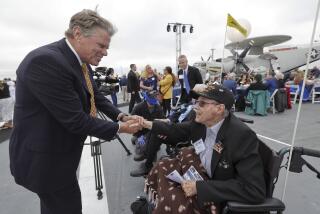Dropping a Bomb on Who Actually Named the Liberator
- Share via
When you think of it, the name was a natural: Liberator.
Not just a letter and a number or something macho and menacing. Instead, something both moralistic and fiercely resolute.
Some 6,724 Liberators were made at San Diego’s Consolidated Aircraft, long-range bombers that played a decisive role in winning World War II.
If certain Army generals had had their way, the B-24 would never have been called the Liberator. The War Department had a strict policy against names.
“I’ve seen a memo from 1940 where an Army general said there would never be names for our planes, never,” said Ray Wagner, archivist at the San Diego Aerospace Museum. “By 1941, there had been a change, and our planes were being given names.”
So who came up with the name Liberator? Depends on which historical source you believe.
In 1964, Dorothy Fleet, wife of Consolidated founder Reuben H. Fleet, took credit for the name Liberator in her biography of her husband and his company, “Our Flight to Destiny.”
Indeed, Dorothy Fleet had a creative flair and in 1940 had penned a patriotic song called “Wake Up America.” First verse:
There’s a God-fearing land for whose honor we stand,
Ready to face any foe.
Our allies are near in our hemisphere
And Love is the watchword we know.
Dorothy Fleet’s claim to the name Liberator stood unchallenged until 1971, when historian Bill Wagner (no relation to Ray) wrote, “Reuben H. Fleet: The Story of Consolidated Aircraft.”
Bill Wagner said that, while it may have been Dorothy Fleet who relayed the suggestion to her husband, the first person to suggest the name Liberator was the Fleets’ English nanny.
Ray Wagner, the archivist, declines to adjudicate the question of Mrs. Fleet versus the nanny, although he notes the English have a long tradition of naming aircraft.
“Sometimes in a conversation between two people, it’s hard to remember who said what first,” he said tactfully.
A Familiar Refrain
Just how different was the pre-World War II San Diego from the metropolis of today?
Depends on how you look at it. Times reporter Greg Johnson, combing through old documents, found some striking similarities between then and now.
The Chamber of Commerce in 1940 urged that “steps toward solving San Diego’s water distribution and supply problem should be taken without delay.”
Just before the attack on Pearl Harbor, the commander of the San Diego destroyer base complained that “San Diego’s public enemy No. 1 is sewage disposal.”
Reuben H. Fleet took congressmen on a prewar cruise of San Diego Bay and demanded that they lean overboard and smell the stink of raw sewage.
A full year before the war began, the Chamber of Commerce noted that growth was outpacing the city’s ability to cope.
And later, the chamber urged San Diego “to tackle its library problem (by eliminating) the overcrowded condition of the downtown library.”
Water shortages. Sewage spills. Out - of - control growth. A shabby downtown library.
Whatever became of those problems?
Top Banana
Yes, we have no bananas.
John Mabee is known today as the founder of the Big Bear supermarket chain. But he started his first market, Mabee’s, in Southeast San Diego in 1944.
Wartime shortages required ingenuity. Mabee “quickly learned the system” of befriending wholesalers and parceling out high-demand items:
“You had to hide the products because if you put it all out on the shelves it was gone in five minutes.”
Because of scarcity, bananas were a delicacy. There were two banana dealers in San Diego.
“Even though we were supposed to line up in only one guy’s line, if you could get by, you lined up in both lines,” Mabee said, “and got two stacks of bananas.”
Result: Mabee’s had bananas.
The rest is history.
More to Read
Sign up for Essential California
The most important California stories and recommendations in your inbox every morning.
You may occasionally receive promotional content from the Los Angeles Times.













